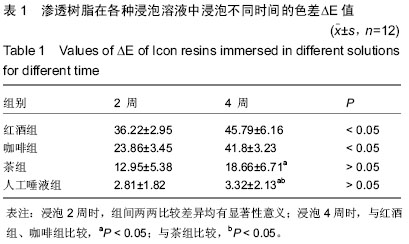| [1] Borges BC,de Souza Borges J,et al.Update on nonsurgical, ultraconservative approaches to treat effectively non-cavitated caries lesions in permanent teeth.Eur J Dent. 2011;5(2):229-236.
[2] 赵陆.氟制剂与CPP-ACP促进牙釉质再矿化效果的体外对比研究[D].吉林:吉林大学,2013.
[3] Srinivasan N,Kavitha M,Loganathan SC.Comparison of the remineralization potential of CPP-ACP and CPP-ACP with 900 ppm fluoride on eroded human enamel: an in situ study. Arch Oral Biol.2010;55(7):541-544.
[4] 李淑慧,吴佩玲.酪蛋白磷酸多肽-无定形磷酸钙在口腔治疗中的研究应用[J].牙体牙髓牙周病学杂志,2011,21(10):601-603.
[5] Anderson AM,Kao E,Gladwin M,et al.The effects of argon laser irradiation on enamel decalcification:An in vivo study.Am J Orthod Dentofacial Orthop.2002;122(3):251 -259.
[6] 刘永红,葛立宏,陈惠珍.渗透树脂对乳、恒磨牙邻面早期龋损渗透能力的对比研究[J].华西口腔医学杂志,2013,31(2):161-164.
[7] 刘子晗,朱玲.早期龋渗透树脂治疗的研究进展[J].口腔生物医学,2011,2(3):155-157.
[8] Rocha Gomes Torres C,Borges AB,Torres LM,et al.Effect of caries infiltration technique and fluoride therapy on the colour masking of white spot lesions.J Dent.2011;39(3):202-207.
[9] Paris S,Meyer-Lueckel H.Resin infiltration of aritificial enamel caries lesions with experimental light curing resins.Dent Mater J.2007;26(4):582-588.
[10] Kantovitz KR,Pascon FM,Nobre-dos-Santos M,et al.Review of the effects of infiltrants and sealers on non-cavitated enamel lesions.Oral Healtk Prev Dent.2010;8(3):295-305.
[11] Ertas E,Guler AU,Yucel AC,et al.Color stability of resin composites after immersion in different drinks.Dent Mater. 2006;25(2):371-376.
[12] Neuhaus KW,Graf M,Lussi A,et al.Late infiltration of post-orthodontic white spot lesions.J Orofac Orthop.2010; 71(6):442-447.
[13] Muñoz MA,Arana-Gordillo LA,Gomes GM,et al.Alternative esthetic management of fluorosis and hypoplasia stains: blending effect obtained with resin infiltration technique.J Esthet Restor Dent.2013;25(1):32-39.
[14] Schlueter N,Duran A,Klimek J,et al.Investigation of the effect of various fluoride compounds and preparations thereof on erosive tissue loss in enamel in vitro.Caries Res.2009;43(1): 10-16.
[15] 黄冠玮,邹玲,李伟.人工龋模型的建立方法[J].国际口腔医学杂志,2010,3(5):537-540.
[16] 叶玲,苏勤.体外人工龋模型的建立方法及检测新技术[J].广东牙病防治,2002,10(4):310-311.
[17] AobaT.Solubility properties of human tooth mineral and pathogenesis of dental caries.J Oral Dis.2009;10(5):249-257.
[18] 楚金普,郝玉庆,李继遥,等.两种脱矿体系制备人工龋损的病理学比较[J].中国比较医学杂志,2008,18(1):23-26.
[19] ten Cate JM,Damen JJ,Buijs MJ.Inhibition of dentin demineralization by fluoride in vitro.Caries Res.1998; 32(2): 141-147.
[20] Cörekçi B,Irg?n C,Malkoç S,et al.Effects of staining solutions on the discoloration of orthodontic adhesives: An in-vitro study.Am J Orthod Dentofacial Orthop.2010;138(6):741-746.
[21] O'Briem WJ,Groh CL,Boenke KM.A new small color difference equation for dental shades.J Dent Res.1990;69(11): 1762-1764.
[22] Douglas RD,Brewer JD.Acceptability of shade difference in metal ceramic crowns.J Prosthet Dent.1998;79(2):254-260.
[23] Johnston Kao EC.Assessment of appearance match by visual observation and clinical colorimetry.J Dent Res.1989;68(5): 819-822.
[24] 王夏衡,陈利民,高平.Crystaleye数字化比色仪和目测法比色的临床效果比较[J].上海口腔医学,2009,18(3):255-258.
[25] Gray A,Ferguson MM,Wall JG.Wine tasting and dental erosion.Case report.Aust Dent J.1998;43(1):32-34.
[26] 刘欣,刘棍,侯本祥.渗透树脂用于龋病治疗的研究进展[J].北京口腔医学,2012,20(3):172-174.
[27] 赵晓一,高学军.渗透树脂处理釉质白垩斑的表面粗糙度及颜色稳定性[J].北京人学学报:医学版,2014,46(1):53-56.
[28] Oysaed H,Ruyter IE.Water sorption and filler characteristic of composites for use in posterior teeth.J Dent Res.1986; 65(11):1315-1318.
[29] Venz S,Dickens B.NIR-spectroscopic investigation of water sorption characteristics of dental resins and composites.J Biomed Mater Res.1991;25(10):1231-1248.
[30] 窦国文,袁昌青,孙培,等.渗透树脂治疗后早期釉质龋表面抛光必要性研究[J].青岛大学医学院学报,2013,49(4):348-350.
[31] Paravina RD,Ontiveros JC,Powers JM.Accelerated aging effects on color and translucency of bleaching-shade composites.J Ethet Restor Dent.2004;16(2):117-127.
[32] Borges A,Caneppele T,Luz M.et al.Color stability of resin used for caries inf-iltration after exposure to different staining solutions.Oper Dent.2014;39(4):433-440.
[33] Torres CRG,Borges AB,Tomes LMS,et al.Effect of caries infiltration technique and fluoride therapy on the colour masking of white spot lesions.J Dent.2011;39(3):202-207.
[34] Ardu S,Braut V,Gutemberg D,et al.A long-term laboratory test on staining susceptibility of Esthetic composite resin materials. Quintessence Int.2010;41(8):695-702.
[35] Nasim I,Neelakantan P,Sujeer R,et al.Color stability of microfilled, micro-hybrid and nanocomposite resin-an in vitro study.J Dent.2010;38(5):137-142.
[36] Sepulveda-Navarro WF,Arana-Correa BE,Borges CP,et al.Color stability of resins and Nylon as denture base material in beverages.J Prosthodont.2011;20(8):632-638.
[37] Mutlu-Sagesen L,Ergun G,Ozkan Y,et al.Color stability of different denture teeth materials: an in vitro study.J Oral Sci. 2001;43(3):193-205.
[38] Imirzalioglu P,Karacaero O,Yilmaz B,et al.Color stability of denture acryl-ic resins and a soft lining material against tea,coffee, andnicotine.J Prosthodont.2010;19(2):118-124
[39] 储婷,孔凡芝,江玉凤,等.渗透树脂和氟化物处理对早期龋修复及抑制再脱矿作用的体外研究[J].江苏大学学报:医学版,2014, 24(2):149-152. |

.jpg)